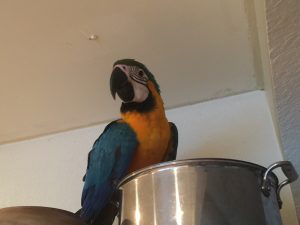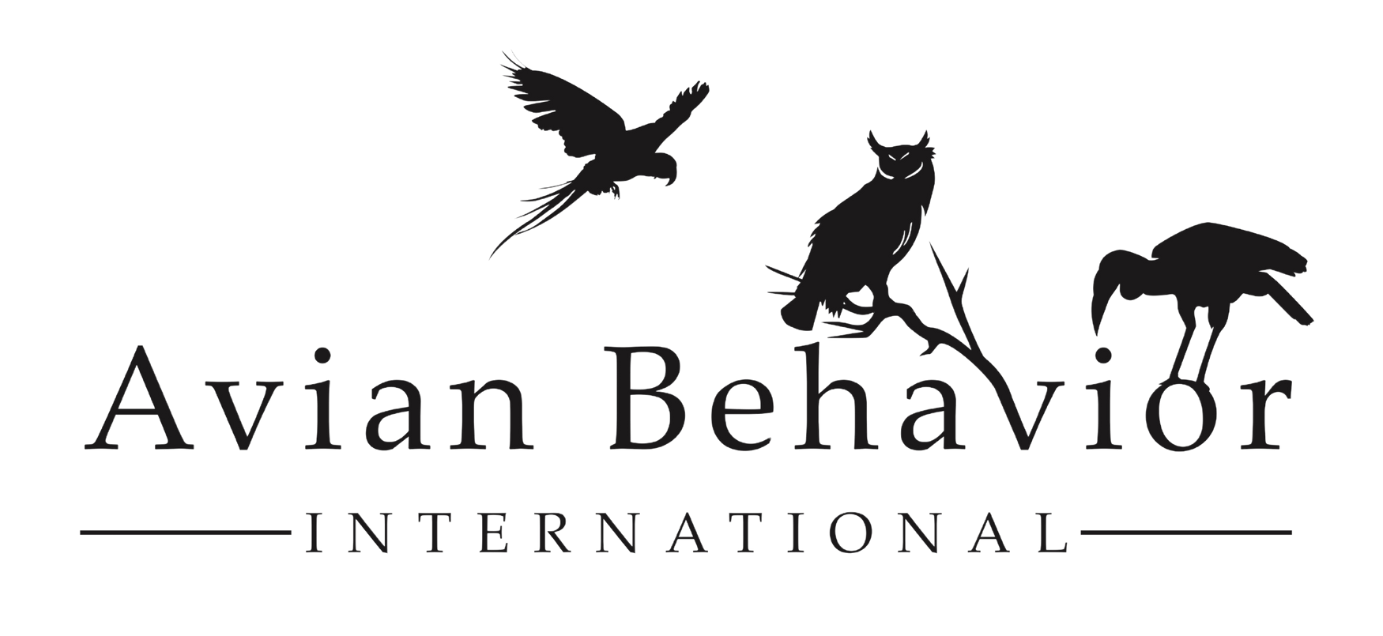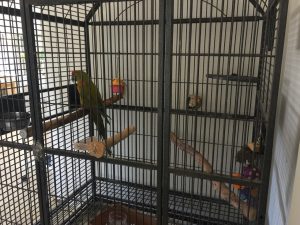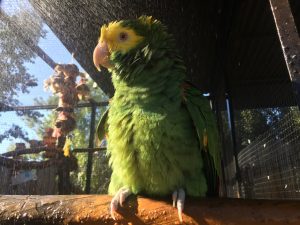
09 Sep Secondary Reinforcers: The Devil You Don’t Know
Do you have a parrot that does not stop screaming and you don’t know why? Or has your bird suddenly refused to step up any more and you can’t figure it out? In an educational program at your zoo, does your bird prefer to sit in a tree overlooking the amphitheater?
If these scenarios sound similar to yours, you are not alone. When we work in structured positive reinforcement training sessions with our birds, we are usually using primary reinforcers: desired food items! But for the times outside of these training sessions or for those of us who aren’t engaging in structured training programs, there are still forces at work that influence our birds’ behavior. The good news is that it doesn’t take much to recognize and harness these influencers for our own and our birds’ benefit.
What Makes a Strong Relationship?
When we think of a strong relationship with our animals, we might think of one that isn’t just based on primary reinforcers, as in those that we need to survive, but also a relationship in which the animal enjoys a variety of secondary reinforcers we provide. They appreciate our presence and attention, pets from us, playing with enrichment items together, when we talk back and forth excitedly, opportunities to bathe, among many other secondary reinforcers. Animals that value these activities are at a comfort level that makes us feel like we have reached a higher level of communication and connectedness.
Benefits of Secondary Reinforcers
One of the benefits of secondary reinforcers is that unlike primary reinforcers, they are more difficult to satiate. They are also highly individual, varying with the animal’s background and preferences, making them virtually limitless. This also means that we can get really creative with our use of secondary reinforcers because we aren’t just confined to the delivery
of food or the feelings of hunger or satiation. For many pet owners, it’s this “desire to be with us” rather than just seeking food that makes us feel that we are more than a trainer but a friend or family member. These types of inadvertent trainers may not in fact realize that they are utilizing reinforcers, but when the relationship starts to take a difficult turn, we are left looking for answers in a relationship we are only seeing part of.
Drawbacks of Secondary Reinforcers
Secondary reinforcers come with some drawbacks that we are going to focus on today. The most prevalent issue is that secondary reinforcers can be hard to spot if you aren’t sure what to look for.
We think of “attention” as a secondary reinforcer that maintains behavior, therefore lack of attention should not be reinforcing to say, screaming. If you have ever been ignored by an upset spouse, you might think that being in the same room but not making eye contact or speaking to the bird constitutes as a lack of attention, or rather, ignoring a behavior. In fact, many people have been given this advice to be confused and frustrated when the parrot continues to scream.
More than likely, a person’s continued presence in the room is still providing enough of a secondary reinforcer to keep maintaining the behavior. And it’s still giving the parrot the impression that opportunities for even more
reinforcers are available as the person remains close by. Only when someone “flies off” would it be clearer to the parrot that there are no opportunities for reinforcement. Making things more difficult is that there are likely other environmental variables that are influencing the behavior, from other birds, pets, and humans, to covert reinforcers that we aren’t privy to.
A parrot that steps up regularly knows that something valuable comes from this action. She gets to be with her person, to be in play area, some couch and TV time, or even a field trip. These are secondary reinforcers that may not be conscious choices we make. But the opportunities we provide our parrots give them information as to how strong that step up behavior will be.
Behavior Breakdown… Secondary Reinforcers?
When our parrot shows signs of not wanting to step up, it likely means that the reinforcing value has changed for the parrot. For instance, if almost every time we step our parrot up, we are putting it back in the cage or putting it down to walk off and do something else, our parrots will associate stepping up with being left alone. There is probably not a lot of reinforcing value in this because are removing the secondary reinforcers such as opportunities to play and socialize. We can counteract this by either adding a desired food item for stepping up and going back in to the cage or make sure we are enhancing the secondary reinforcers like toys or offering some extra snuggles upon stepping in to the home cage.
Another challenge associated with using secondary reinforcers is that sometimes they can get a bird too overexcited, which can lead to aggression. No doubt, many parrots love talking or singing in happy, high-pitched excited voices.
Sometimes they will dance and sing along, too. Opportunities for this kind of interaction can reinforce stepping up, going into or out of cages and even make car rides and field trips more reinforcing. Too much of this can flip a parrot into an over-excited state. This can have your bird charged up and start biting, lunging, or displacing their excitement on to the nearest enrichment item, other bird, cage bars, or even themselves, like a foot or their feathers. If your parrot gets overexcited when you chatter at it, consider bringing your excited talk down to a point where your bird doesn’t react so strongly or find a different reinforcer.
Secondary reinforcers are often hard to control. Parrots, like most arboreal birds, enjoy being up high. With flighted parrots, this is a variable that can be a challenge to manage. How do you keep a bird from getting where you can’t reach, creating nesting or enrichment opportunities you would rather it not, or calling out at strangers or alarming stimuli it can see from its high vantage? In a setting like an educational free flighted bird program, sitting in a tree brings all of these reinforcing opportunities on a larger scale.
The first step is to identify the potential secondary reinforcers and the potential they have to derail your goals. The next step is to provide alternatives that are equally or more attractive to the parrot to engage with. This means these alternatives need to be easy to interact with and just as reinforcing as problem reinforcers.
The Premack Principle
The Premack Principle says that a high probability behavior increases the likelihood of a low probability behavior. A classic example is a dog enjoying going into the car because he often goes to the beach. My dog will literally leap into his harness (low probability behavior) that I have pulled out of the closet in an effort to go on a walk (high probability behavior). Many parrot owners believe that if they can just get their harness on the parrot, he will learn that the harness equals being outside. We also assume the parrot enjoys being outside.
But parrots are different than dogs, with one major variable being that they are prey animals as opposed to predators like  dogs. If they aren’t used to being outdoors, it can be very stressful as a prey animal on the lookout for potential sources of danger. So harnessing and being outside need to be trained so that the value of togetherness and stimulation outweighs the initial stress.
dogs. If they aren’t used to being outdoors, it can be very stressful as a prey animal on the lookout for potential sources of danger. So harnessing and being outside need to be trained so that the value of togetherness and stimulation outweighs the initial stress.
Premack is a lovely behavior principle that allows one activity to reinforce another. Play can reinforce going back to a cage and we can use Premack to help our parrots develop positive associations with new people, as well.
Who’s Training Whom?
I often refer to secondary reinforcers as the devil you don’t know because they can powerfully influence behavior, but they will often go unrecognized. This makes identifying the cause of undesirable behavior a challenge. They can either be relationship destroyers or relationship builders. When we see something that our parrots enjoy doing, we can often harness this power for our mutual benefit. Even those of us – or our clients – that have difficulty implementing formal training sessions using desired food items can utilize secondary reinforcers for a happy, healthy lifestyle.
For more information on how to maximize your relationship with your companion, become a member of the Avian Behavior Lab! Check out the different membership plans here!



